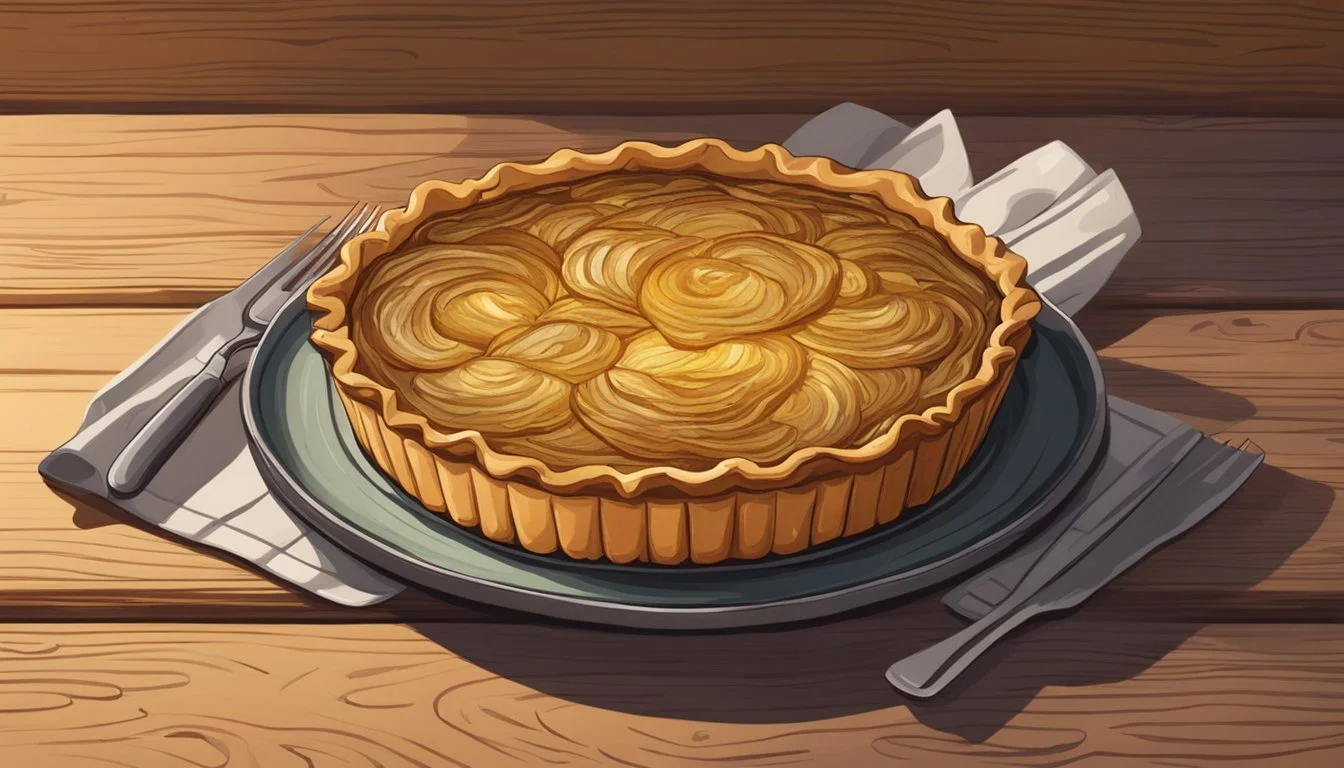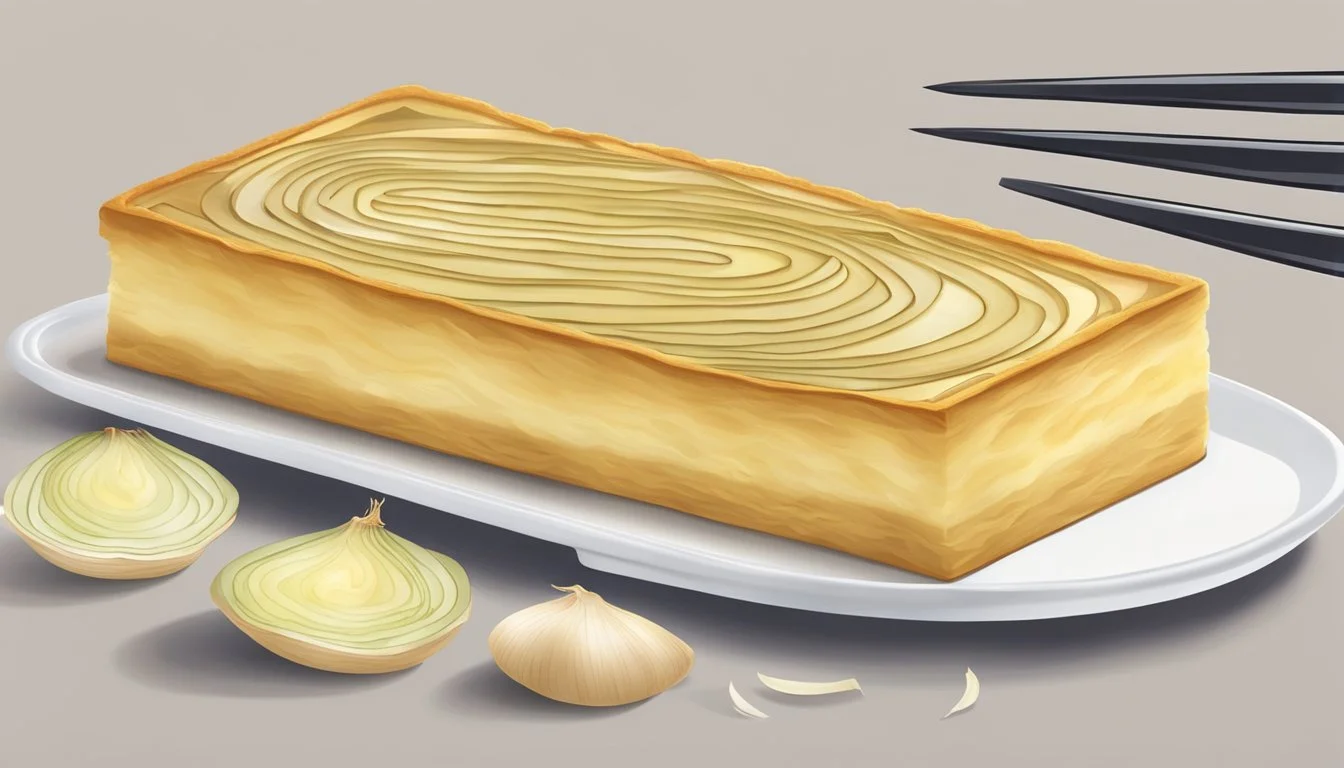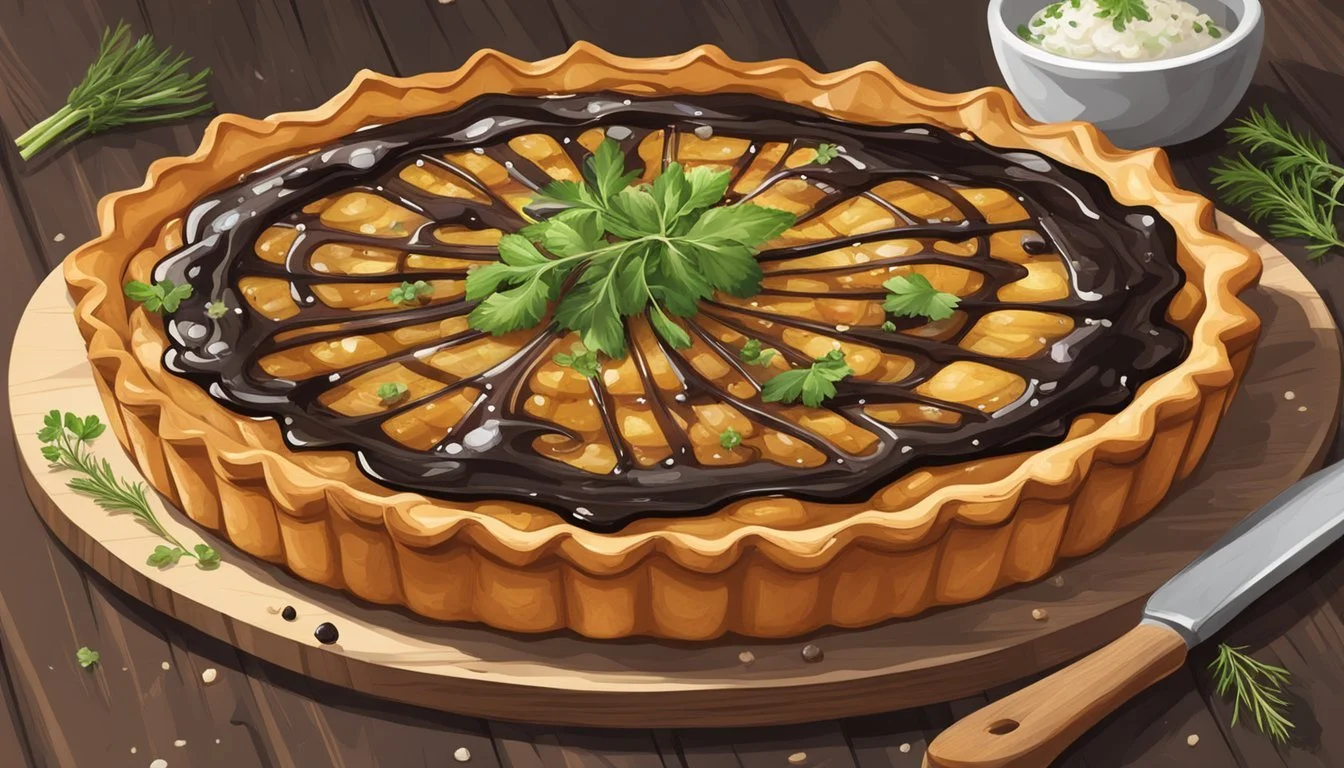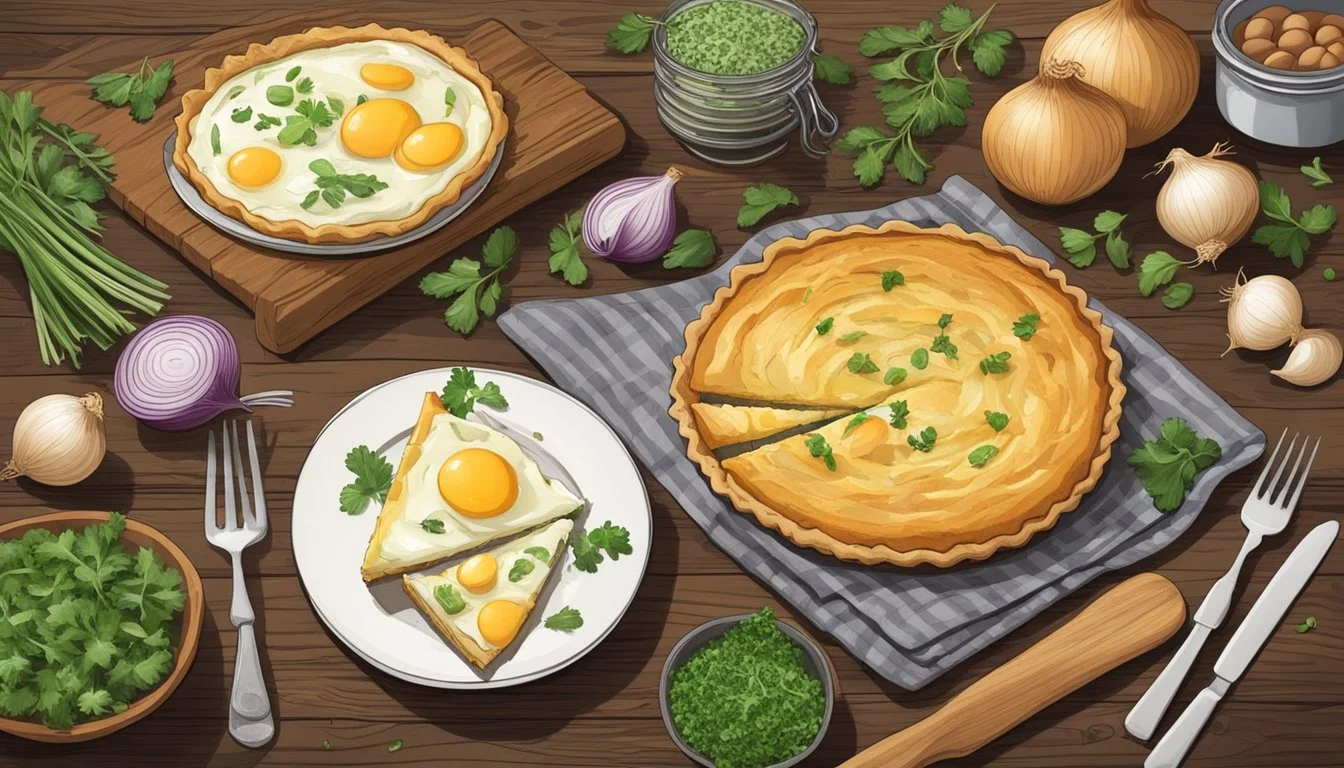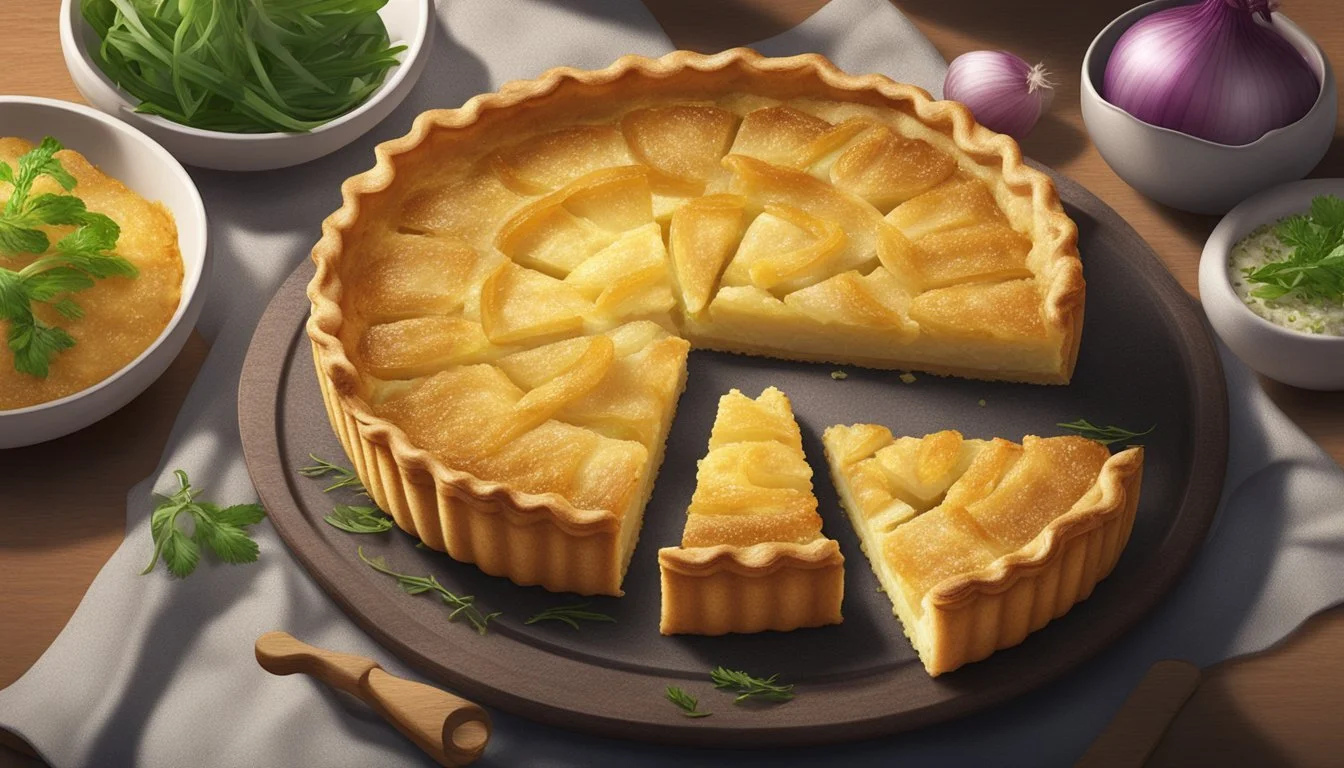How do You Eat an Onion Tart?
Tips for Enjoying This Savory Dish
An onion tart offers diners a classic and versatile dish with a rich flavor profile that can be enjoyed in various settings. Its roots are grounded in European cuisine, where it’s often served as a light entrée or a sophisticated appetizer. The savory pastry, typically comprised of a flaky crust filled with a mixture of caramelized onions (What wine goes well with onions?) and often combined with cheese or other complementary ingredients, provides a balance of sweetness and depth which is pleasing to the palate.
When eating an onion tart, it's traditional to experience it warm, shortly after being baked to appreciate the blend of flavors fully. The dish can be consumed alone or paired with a range of side dishes that enhance its taste and presentation. Among popular pairings are salads, which provide a fresh contrast to the tart’s rich flavor, or glazed vegetables that mirror its sweetness and add color to the meal.
While the onion tart can stand confidently as a meal in its own right, it also fits seamlessly into larger menus for those seeking to impress at a dinner party or to offer a comforting homemade meal to family and friends. Its rich, caramelized filling, embraced by a crisp, buttery pastry, ensures it remains a beloved choice for those who seek a meal that's as delightful to the eyes as it is satisfying to taste.
Ingredients Overview
The success of an onion tart hinges on the selection and balance of quality ingredients. Understanding what each component contributes can elevate the dish from simple to sublime.
Selecting Quality Ingredients
Selecting the finest ingredients lays the groundwork for a truly delectable onion tart. Choosing the right type of onions is foundational; they should be fresh, firm, and devoid of any blemishes. When selecting cheese, opt for Gruyere or Parmesan for their excellent melting properties and depth of flavor. For herbs, fresh thyme imparts a subtle earthiness without overpowering the delicate onion.
Key Ingredients for Onion Tart
An onion tart's quintessence is drawn from its key ingredients, each playing a distinct role. Below is a table displaying these ingredients and their common measurements.
Ingredients Common Measurements Onions 1-2 pounds, thinly sliced Flour 1-2 cups for pastry dough Butter 1/4 - 1/2 cup for dough and sautéing onions Salt To taste, generally 1 tsp for dough Sugar A pinch, to balance the tartness Egg yolks 2-3, for richness in the filling Heavy cream 1 cup, for a creamy filling texture Olive oil 1-2 tbsp for cooking onions Garlic 1-2 cloves, finely minced Herbs 1 tbsp fresh thyme, chopped
Use cold butter to ensure a flaky pastry dough, and season the layers with just the right amount of salt to bring out the flavors. A harmonious blend of egg yolks and heavy cream creates a luxuriously creamy custard that binds the fragrant onions and cheese together, baked to perfection within a buttery pastry shell. A hint of garlic can be added for an aromatic undertone, but it should not be overpowering.
Equipment Needed
Crafting an onion tart requires a mix of essential baking tools and preparation utensils. The right equipment ensures the process is smooth and the results are delectable.
Essential Baking Tools
One must have a reliable oven for baking the tart to perfection. Preparing the tart shell might involve a food processor to blend flour and butter into a coarse meal consistency. A baking sheet, lined with parchment paper or aluminum foil, is needed to lay out the tart dough. This setup prevents sticking and eases removal after baking.
Oven
Food processor
Baking sheet
Parchment paper or Aluminum foil
Preparation Utensils
For the filling preparation, a skillet is essential for sautéing the onions until they're soft and translucent. If available, a mandoline can aid in evenly slicing onions to ensure consistent cooking. Additionally, a variety of utensils like mixing bowls, knives, and spoons, are helpful to assemble ingredients before combining them with the prepared dough.
Skillet
Mandoline (optional but helpful for even slices)
Mixing bowls
Knives
Spoons
Preparing the Tart Base
When crafting an onion tart, one must begin by creating a sturdy and flavorful base. The pastry dough is pivotal in forming an ideal foundation that complements the savory filling.
Making the Pastry Dough
One can opt for puff pastry or pie dough for the tart base. For homemade pastry, one starts by combining flour and salt in a mixing bowl. Chilled butter is then cut into the mixture, which should be worked until it resembles coarse breadcrumbs. Ice water is added gradually to form a dough. Rolling out the dough on a floured surface to the desired thickness and size is a crucial step, as it will shape the final tart shell. Once rolled, the dough should be gently placed into the tart pan and pressed into the corners. The excess dough can be trimmed, leaving a slight overhang. The pressed dough should then be chilled in the refrigerator to firm up before baking.
Blind Baking the Crust
Blind baking involves partially baking the crust before adding the filling. The chilled tart shell should first be lined with foil or parchment paper, and then filled with baking weights or dried beans to prevent the dough from puffing up. The crust is then baked in a preheated oven until it is just beginning to color. After removing the weights and foil, it is advisable to return the crust to the oven to finish baking until it’s fully set and lightly golden. This process ensures that the base is crisp and will hold up to the moisture of the onion filling.
Assembling the Filling
Creating the perfect onion tart filling involves cooking onions to a rich caramelized state and then blending them with complementary ingredients that enhance their flavor.
Preparing the Onion Mixture
To begin, one must caramelize the onions. Select a large pan and heat oil over medium-high heat. Introduce yellow onions to the pan, and cook them until they soften, which typically takes about 10 minutes. Once softened, add a pinch of kosher salt and a sprinkle of sugar to encourage the caramelization process. This may take around 20 minutes, as the onions turn a deep golden brown—indicative of perfectly caramelized onions.
Combining with Other Ingredients
Once the onions are caramelized, allow them to cool slightly. They are then ready to be combined with the other elements that make up the filling. In a separate bowl, beat eggs with heavy cream until well mixed. To this, add seasonings like kosher salt, black pepper, and nutmeg for flavor. Incorporate some fresh thyme leaves for an aromatic touch. For a savory note, one could also include cooked and chopped bacon (how long does bacon last?). Mix these ingredients with the caramelized onions to create a harmonious and flavorful tart filling.
Baking the Tart
When it comes to baking an onion tart, precise heat management and timing are key to achieving that desirable golden and crisp finish. Here's how one can ensure their tart is baked to perfection.
Setting the Oven
One should begin by preheating their oven, which is critical for even baking. For most onion tart recipes, the recommended temperature tends to be around 350 degrees Fahrenheit (175 degrees Celsius). It's important to use an oven thermometer to verify the accuracy of the oven's internal temperature, as this can sometimes differ from the set temperature. While the oven preheats, one can take this time to prepare the tart's filling and crust, if not done already.
Baking to Perfection
Baking the tart requires close attention. The tart should be placed on the middle rack to ensure even heat distribution. To protect the edges of the crust from browning too quickly, one might wrap them with foil. If the recipe calls for it, blind baking the crust prior to adding the filling can lead to a more crisp foundation.
A general guideline for baking the onion tart is to bake until the filling is set and the top is a golden hue. This typically requires about 20-25 minutes, depending on the specific recipe and oven variations. Halfway through baking, it's recommended to rotate the tart to ensure it colors evenly. One should always keep a watchful eye as the tart nears completion to prevent over-baking, which can lead to a dry texture.
Using a timer and periodically checking the tart can prevent under or over-baking. Once done, the tart should be removed carefully from the oven and placed on a cooling rack. It's best to let it rest for a few minutes to set before serving.
Serving and Presentation
Serving an onion tart correctly enhances both its flavors and presentation. The tart can stand as a hearty appetizer or a main dish, and its successful service involves proper resting and cutting, along with thoughtful accompaniments and garnishing.
Resting and Cutting
Once an onion tart is removed from the oven, it should rest. Resting allows the tart to set, making it easier to cut into neat slices. A resting period of 10 to 15 minutes is sufficient. For cutting, use a sharp knife or a pizza cutter to ensure the pastry doesn't crumble, slicing the tart into wedges if round, or into square portions if rectangular.
Accompaniments and Garnishing
Accompaniments:
Serve the tart as an appetizer or pair it with one of the following side dishes:
Side Dish Description Green Salad A simple green salad with a light vinaigrette balances the rich flavors. Honey Glazed Carrots Sweet and colorful, providing a contrast to the savory tart.
Consider a drizzle of balsamic reduction for added depth of flavor.
Garnishing:
Garnishes should be simple to complement the tart's rich flavor:
A dollop of crème fraîche or sour cream can offer a tangy contrast.
Fresh herbs like thyme or sage can be sprinkled on top for extra aroma and a hint of color.
Storage and Reheating
Properly storing and reheating an onion tart can ensure that it retains its delicious taste and texture. The section below guides you on how to store leftovers and reheat them to achieve the best quality.
Storing Leftovers
One should wrap the leftover onion tart in aluminum foil or plastic wrap to maintain freshness before placing it in the refrigerator. It's important to store the tart within two hours of serving to prevent the growth of bacteria. The refrigerator temperature should ideally be set at or below 40°F to keep the tart safe for consumption.
Reheating for Best Quality
When reheating, remove the tart from the refrigerator and let it sit at room temperature for about 15 minutes before warming. This allows for more even heating. For best results, reheat the tart in an oven preheated to 350°F until it is heated through. This method helps preserve the flakiness of the pastry and prevents sogginess. Typically, it takes about 10-15 minutes to warm the tart thoroughly. A microwave can be used for faster reheating, but this may alter the texture of the pastry.
Nutritional Information
When considering the nutritional profile of an onion tart, it is important to look at its caloric content and dietary considerations. This savory dish can vary in its nutritional values based on its ingredients and preparation method.
Caloric Content
On average, an onion tart contains 184 calories per 100 grams. The calories primarily come from a combination of fats, proteins, and carbohydrates found within the tart.
Dietary Considerations
A typical onion tart consists of the following macronutrient composition:
Fat: 9%
Protein: 7%
Carbohydrates: 18%
The tart may be suitable for vegetarian diets, containing mostly plant-based ingredients, although it's important to verify whether the crust or any added ingredients align with vegetarian standards. As a dish often regarded as comfort food, one should be aware that while satisfying, it should be consumed in moderation within a balanced diet.
Additional Tips and Tricks
Mastering the preparation and enjoyment of an onion tart can turn a simple dish into a culinary delight. Successfully bringing out the inherent flavors and handling the pastry with finesse are crucial steps.
Enhancing Flavors
For a savory tart, one should consider the type of onions used. Sweet onions are ideal for a milder, sweeter profile, while brown onions, which are more pungent, add depth. To accentuate the tart's rich flavors, red onions may be caramelized to a sweet, savory note. Some chefs suggest a touch of Dijon mustard spread over the crust before adding the onion mixture to give an extra flavor kick.
Salted butter can be used to sauté onions, lending a gentle seasoning as they cook.
A pinch of freshly ground black pepper is often recommended to complement the natural sweetness of the caramelized onions as well.
Working with Puff Pastry
A light, flaky pastry is the canvas for an onion tart.
Opt for unsalted butter or even lard when preparing the pastry to control the overall saltiness of the dish.
It is important to keep the pastry cold before baking to ensure it puffs up, so be patient and avoid rushing this process.
Roll out the puff pastry on a lightly floured surface:
Ensure it is even and fits the tart pan.
Trim excess pastry with a sharp knife for a clean edge.
Pre-baking, or 'blind baking', could be beneficial to prevent a soggy base, especially when using a moist onion mixture.
Variations of Onion Tart
Onion tarts offer a versatile canvas for myriad flavor combinations, from classic French inspirations to inventive vegetarian and meaty twists. These variations can elevate the humble onion to a gourmet level.
Alternative Onion Tart Recipes
Substantial diversity exists within onion tart recipes. A traditional French Onion Tart involves caramelizing onions until they are sweet and silky, often enhanced with a hint of sugar to bring out their natural sweetness. For pastry, a flaky puff pastry base is preferred for its buttery taste and delicate texture.
A more rustic variation is found in a Galette, a free-form crusty pastry that encases the onions in a more casual, yet equally delightful presentation. Some may opt to enrich the filling with Manchego cheese, a Spanish cheese that imparts a distinctive, sharp flavor.
For those interested in a different approach, reimagining the onion tart as a Quiche (What wine goes well with quiche?) could offer a more substantial dish. By adding eggs and cream to the caramelized onions and baking them in a pie crust, diner receives a richer and more filling meal.
Vegetarian and Meat Options
Use olive oil or butter for caramelizing onions to ensure the dish remains vegetarian-friendly.
Incorporate a blend of cheeses, such as goat cheese or Manchego, for added depth.
Meat Options:
For a hearty flavor, consider sautéing onions in bacon fat before adding to the tart.
Smoked ham or crumbled bacon can be sprinkled on top for a satisfying savory note.
Both variations can include ingredients like thyme or rosemary for aromatic herbal undertones, resulting in a Savory French Onion Tart that appeals to a broad spectrum of palates. Whether opting for a meat-based or vegetarian tart, one can customize the recipe to suit individual tastes while retaining the quintessential qualities of the classic dish.
Conclusion
Enjoying an onion tart is best when the dish is served golden and crisp, with a tender center. To achieve this, it’s crucial to follow the recipe closely and respect both the prep time and cook time. After baking, one should allow the tart to rest for a short period; this ensures the filling sets, and the flavors develop fully.
When preparing an onion tart, the total prep time typically ranges around 30 minutes, while the cook time may extend up to an hour. Consequently, the total time from start to completion is generally about 1.5 hours. It’s advisable to verify that the onions are caramelized to perfection—soft, sweet, and deep brown without being burnt.
To serve, a slice of onion tart pairs well with a fresh green salad, offering a balanced, satisfying experience. Each bite into the flaky crust, topped with the savory, aromatic onion filling, confirms the delight that this classic dish brings to the palate.
For storage, one should keep any leftovers in an airtight container and refrigerate. When reheating, opt for the oven over the microwave to maintain the crust’s crispness.
In conclusion, an onion tart's success lies in the precision of its making and the simplicity of its enjoyment. It invites a moment of pause to savor the marriage of rustic simplicity and culinary finesse.


